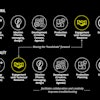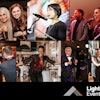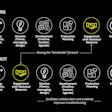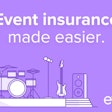
Chatbots are one of the hottest tech tools for marketing right now. Brands such as Patron, British Airways, American Express, and more are using the artificial intelligence-powered systems to communicate with customers to drive engagement and retention. Bots also are gaining popularity at events such as conferences, trade shows, and festivals where the automated system can answer questions from attendees faster and more efficiently than human-powered responses.
The bots serve as a virtual concierges, able to help attendees find out the location of sessions, the Wi-Fi password, speaker bios, meal times, etc. Bots can operate through Facebook Messenger, text messaging, or be integrated into event websites and apps, and they can be used to share images, videos, GPS locations, polls, and more.
In May, BizBash used a chatbot for the first time at BizBash Live: Florida, a one-day conference and expo in Fort Lauderdale. The bot, dubbed “Betty,” fielded 1,630 questions from attendees before, during, and after the event. It will return for BizBash Live: Los Angeles on July 19.
To help you understand how to effectively use a chatbot, BizBash gathered ideas from two companies that provide bots for events. Kristi Colleran is co-founder of Sciens.io, maker of Concierge EventBot, which powered “Betty.” Varun Kashiv is director of business solutions for Event2Mobile, which makes a chatbot for event apps that it calls Eva. Here are their suggestions for implementing a chatbot at your event.
1. Create a personality for your bot that aligns with your event’s brand, theme, etc. “Think about what you name it, the personality you give it, how information is presented,” Colleran says. “The bot can be an ambassador for your event.”
2. Make use of all of the available channels for your bot. For example, Colleran suggests planners launch the bot on the event website first since that is likely where attendees will go to learn about and register for the event. Use this as a “soft launch” opportunity to understand what people are asking and ensure the bot has appropriate content. Then, a few days before the event, add Facebook Messenger and text-messaging options.
3. Since this is such new technology, communication is critical to ensure attendees know that the bot is available and that they understand what it can do. If the bot is integrated with your registration system, send a welcome message to attendees’ cell-phone numbers explaining how to use the bot and provide examples of the type of information it can provide.
“It’s not Siri and it’s not Amazon Echo. This is a focused bot that is supposed to answer event-specific questions, for example about speakers, attendees, setting up meetings,” Kashiv says. “We can add fun and humor, but it definitely has to be focused and people have to know that.”
4. For large events with different subsets of attendees, send customized messages based on those groups's needs. For example, send a different message to exhibitors versus buyers, explaining how the bot can help them.
5. Make sure the content in the bot is representative of the content that is being shared on other communication channels, such as Twitter, Facebook, etc. “We had a client that had a fun run and every time they tweeted about it, they would get questions in the bot,” Colleran says.
6. Monitor the comments being made in the bot. Guests may use it to alert staff to issues, such as that the parking lot is full or a room is hot. Staff can then communicate directly with the attendee through a private support channel. During the event, add information to the bot to answer questions that had not been anticipated.
7. Consider creating kiosks around the event—like self-service information counters—with a tablet that guests can use to access the bot. Guests may prefer not to use it from their text messaging.
8. Don’t overdo push notifications and do provide clear instructions to attendees on how to opt out of them. “We encourage using them for high-value things, like notifying that a survey is available and providing a link to download it, or notifying about special elements such as the coffee bar is open. But use them cautiously, because people do get irritated,” Colleran says.
9. After the event, review how attendees used the bot, the type of information they requested, and any issues that arose. Use that data to make the bot “smarter” for the next time it will be used.



















